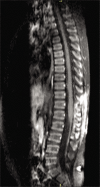Intramedullary spinal schistosomiasis in a child with acute myelopathy: A case report
- PMID: 33408905
- PMCID: PMC7771502
- DOI: 10.25259/SNI_484_2020
Intramedullary spinal schistosomiasis in a child with acute myelopathy: A case report
Abstract
Background: Neuroschistosomiasis is defined as an infection of the nervous system caused by Schistosoma mansoni. Neuroschistosomiasis is an important differential diagnostic consideration in pediatric patients presenting with myelopathy. Surgical excision combined with antiparasitic drugs typically provides a satisfactory outcome and often results in neurological recovery.
Case description: A 4-year-old child presented with acute and progressive myelopathy. A thoracolumbar magnetic resonance image revealed a T12-L2 conus medullaris mass that was isointense on T1 and hyperintense on T2 (with an extensive syringomyelia at the thoracic spinal cord) and showed enhanced heterogeneity with gadolinium. The lesion was excised through T12-L2 laminotomy. Intraoperatively, the tumor appeared reddish and infiltrative. The frozen section suggested a granulomatous process, while the final pathology confirmed conus medullaris schistosomiasis.
Conclusion: Schistosomal myeloradiculopathy should be considered among the different diagnosis in children presenting with lower thoracic region, conus medullaris, and/or cauda equina infiltrative spinal masses.
Keywords: Conus medullaris; Myelopathy; Neuroschistosomiasis; Schistosomiasis; Spinal.
Copyright: © 2020 Surgical Neurology International.
Conflict of interest statement
There are no conflicts of interest.
Figures



Similar articles
-
A case report of conus intramedullary mansoni neuroschistosomiasis.Surg Neurol Int. 2023 Apr 21;14:139. doi: 10.25259/SNI_47_2023. eCollection 2023. Surg Neurol Int. 2023. PMID: 37151453 Free PMC article.
-
[Myelopathy due to Schistosoma mansoni. A description of two cases and review of the literature].Rev Neurol. 2004 Jul 16-31;39(2):137-41. Rev Neurol. 2004. PMID: 15264164 Spanish.
-
Myeloradiculopathy associated to Schistosoma mansoni.BMJ Case Rep. 2011 Aug 11;2011:bcr1220103631. doi: 10.1136/bcr.12.2010.3631. BMJ Case Rep. 2011. PMID: 22688491 Free PMC article.
-
Neurological complications of Schistosoma infection.Trans R Soc Trop Med Hyg. 2008 Feb;102(2):107-16. doi: 10.1016/j.trstmh.2007.08.004. Epub 2007 Oct 1. Trans R Soc Trop Med Hyg. 2008. PMID: 17905371 Review.
-
Neuroschistosomiasis.Expert Rev Anti Infect Ther. 2010 Nov;8(11):1307-18. doi: 10.1586/eri.10.111. Expert Rev Anti Infect Ther. 2010. PMID: 21073294 Review.
Cited by
-
Insights into diagnostics and management of spinal neuroschistosomiasis: A scoping review of 230 cases of a neglected disease.Acta Neurol Belg. 2025 Jul 1. doi: 10.1007/s13760-025-02833-9. Online ahead of print. Acta Neurol Belg. 2025. PMID: 40588589 Review.
-
A case report of conus intramedullary mansoni neuroschistosomiasis.Surg Neurol Int. 2023 Apr 21;14:139. doi: 10.25259/SNI_47_2023. eCollection 2023. Surg Neurol Int. 2023. PMID: 37151453 Free PMC article.
References
-
- Camargo ST, Dantas FR, Teixeira AL. Schistosomal myelopathy mimicking spinal cord neoplasm. Scand J Infect Dis. 2005;37:365–98. - PubMed
-
- Kim AH, Maher CO, Smith ER. Lumbar intramedullary spinal schistosomiasis presenting as progressive paraparesis: Case report. Neurosurgery. 2006;58:E996. - PubMed
-
- Labeodan AO, Sur M. Intramedullary schistosomiasis. Pediatr Neurosurg. 2003;39:14–6. - PubMed
-
- Lighter J, Kim M, Krasinski K. Intramedullary schistosomiasis presenting in an adolescent with prolonged intermittent back pain. Pediatr Neurol. 2008;39:44–7. - PubMed
Publication types
LinkOut - more resources
Full Text Sources
